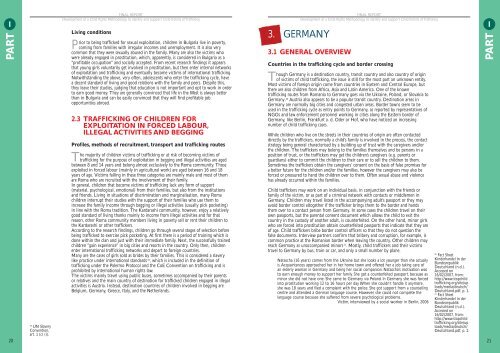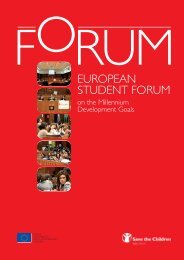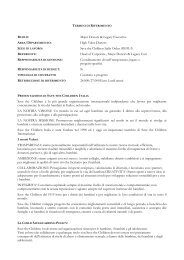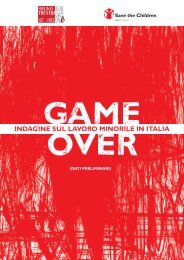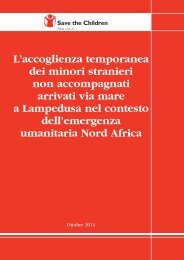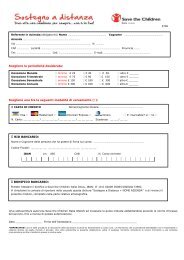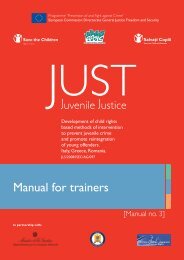IPART2019UN SlaveryConvention,art. 1 (c) (i).<strong>FINAL</strong> <strong>REPORT</strong>Development of a Child Rights Methodology to Identify and Support Child Victims of TraffickingLiving conditionsPrior to being trafficked for sexual exploitation, children in Bulgaria live in poverty,coming from families with irregular incomes and unemployment. It is also verycommon that <strong>the</strong>y were sexually abused in <strong>the</strong> family. Many are also <strong>the</strong> victims whowere already engaged in prostitution, which, apparently, is considered in Bulgaria as a“profitable occupation” and socially accepted. From recent research findings it appearsthat young girls voluntarily get involved in prostitution, but <strong>the</strong>n enter internal networksof exploitation and trafficking and eventually become victims of international trafficking.Notwithstanding <strong>the</strong> above, very often, adolescents who enter <strong>the</strong> trafficking cycle, havea decent standard of living and good relations with <strong>the</strong> family and peers. Despite this,<strong>the</strong>y leave <strong>the</strong>ir studies, judging that education is not important and opt to work in orderto earn good money. They are generally convinced that life in <strong>the</strong> West is always betterthan in Bulgaria and can be easily convinced that <strong>the</strong>y will find profitable jobopportunities abroad.2.3 TRAFFICKING OF CHILDREN FOREXPLOITATION IN FORCED LABOUR,ILLEGAL ACTIVITIES AND BEGGINGProfiles, methods of recruitment, transport and trafficking routesThe majority of children victims of trafficking or at risk of becoming victims oftrafficking for <strong>the</strong> purpose of exploitation in begging and illegal activities are agedbetween 8 and 14 years and belong almost exclusively to <strong>the</strong> Roma community. Thoseexploited in forced labour (mainly in agricultural work) are aged between 16 and 18years of age. Victims falling in <strong>the</strong>se three categories are mainly male and most of <strong>the</strong>mare Roma who are recruited with <strong>the</strong> involvement of <strong>the</strong>ir family.In general, children that become victims of trafficking lack any form of support(material, psychological, emotional) from <strong>the</strong>ir families, but also from <strong>the</strong> institutionsand friends. Living in situations of discrimination and marginalisation, many Romachildren interrupt <strong>the</strong>ir studies with <strong>the</strong> support of <strong>the</strong>ir families who use <strong>the</strong>m toincrease <strong>the</strong> family income through begging or illegal activities (usually pick pocketing)in line with <strong>the</strong> Roma tradition. The Kardarashi community, however, enjoy a relativelygood standard of living thanks mainly to income from illegal activities and for thatreason, o<strong>the</strong>r Roma community members living in poverty sell or rent <strong>the</strong>ir children to<strong>the</strong> Kardarashi or o<strong>the</strong>r traffickers.According to <strong>the</strong> research findings, children go through several stages of selection beforebeing trafficked to exercise pick pocketing. At first <strong>the</strong>re is a period of training which isdone within <strong>the</strong> clan and just with <strong>the</strong>ir immediate family. Next, <strong>the</strong> successfully trainedchildren “gain experience” in big cities and resorts in <strong>the</strong> country. Only <strong>the</strong>n, childrenenter international trafficking networks and depart to foreign countries.Many are <strong>the</strong> cases of girls sold as brides by <strong>the</strong>ir families. This is considered a slaverylike practice under international standards 19 , which is included in <strong>the</strong> definition oftrafficking under <strong>the</strong> Palermo Protocol and <strong>the</strong> CoE Convention on trafficking and isprohibited by international human rights law.The victims mainly travel using public buses, sometimes accompanied by <strong>the</strong>ir parentsor relatives and <strong>the</strong> main country of destination for trafficked children engaged in illegalactivities is Austria. Instead, destination countries of children involved in begging areBelgium, Germany, Greece, Italy, and <strong>the</strong> Ne<strong>the</strong>rlands.3. GERMANY<strong>FINAL</strong> <strong>REPORT</strong>Development of a Child Rights Methodology to Identify and Support Child Victims of Trafficking3.1 GENERAL OVERVIEWCountries in <strong>the</strong> trafficking cycle and border crossingThough Germany is a destination country, transit country and also country of originof victims of child trafficking, <strong>the</strong> issue is still for <strong>the</strong> most part an unknown entity.Most victims of foreign origin come from countries in Eastern and Central Europe, but<strong>the</strong>re are also children from Africa, Asia and Latin America. One of <strong>the</strong> knowntrafficking routes from Romania to Germany goes via <strong>the</strong> Ukraine, Poland, or Slovakia toGermany. 20 Austria also appears to be a popular transit country. Destination areas inGermany are normally big cities and congested urban areas. Border towns seem to beused in <strong>the</strong> trafficking cycle as entry points to Germany, as reported by representatives ofNGOs and law enforcement personnel working in cities along <strong>the</strong> Eastern border ofGermany, like Berlin, Frankfurt a. d. Oder or Hof, who have noticed an increasingnumber of child trafficking cases.While children who live on <strong>the</strong> streets in <strong>the</strong>ir countries of origin are often contacteddirectly by <strong>the</strong> traffickers, normally a child’s family is involved in <strong>the</strong> process, <strong>the</strong> contactstrategy being general characterised by a building up of trust with <strong>the</strong> caregivers and/or<strong>the</strong> children. The traffickers may belong to <strong>the</strong> families <strong>the</strong>mselves and be persons in aposition of trust, or <strong>the</strong> traffickers may get <strong>the</strong> children’s caregivers (e.g. parents orguardians) ei<strong>the</strong>r to commit <strong>the</strong> children to <strong>the</strong>ir care or to sell <strong>the</strong> children to <strong>the</strong>m.Sometimes <strong>the</strong> traffickers obtain <strong>the</strong> caregivers’ consent on <strong>the</strong> basis of false promises fora better future for <strong>the</strong> children and/or <strong>the</strong> families, however <strong>the</strong> caregivers may also beforced or pressured to hand <strong>the</strong> children over to <strong>the</strong>m. Often sexual abuse and violencehas already occurred within <strong>the</strong> families.Child traffickers may work on an individual basis, in conjunction with <strong>the</strong> friends orfamily of <strong>the</strong> victim, or as part of a criminal network with contacts or middlemen inGermany. <strong>Children</strong> may travel listed in <strong>the</strong> accompanying adult’s passport or <strong>the</strong>y mayavoid border control altoge<strong>the</strong>r if <strong>the</strong> trafficker brings <strong>the</strong>m to <strong>the</strong> border and hands<strong>the</strong>m over to a contact person from Germany. In some cases <strong>the</strong> children travel on <strong>the</strong>irown passports, but <strong>the</strong> parental consent document which allows <strong>the</strong> child to exit <strong>the</strong>country in <strong>the</strong> custody of ano<strong>the</strong>r adult, is counterfeited. On <strong>the</strong> o<strong>the</strong>r hand, minor girlswho are forced into prostitution obtain counterfeited passports that indicate that <strong>the</strong>y areof age. Child traffickers bribe border control officers so that <strong>the</strong>y do not question <strong>the</strong>false documents. Interview partners confirm that bribery and corruption, for example, iscommon practice at <strong>the</strong> Romanian border when leaving <strong>the</strong> country. O<strong>the</strong>r children mayreach Germany as unaccompanied minors 21 . Mostly, child traffickers and <strong>the</strong>ir victimstravel to Germany by bus, train or car, and only a small number by plane.Natascha (16 years) comes from <strong>the</strong> Ukraine but she looks a lot younger than she actuallyis. Acquaintances approached her in her home town and offered her a job taking care ofan elderly woman in Germany and being her social companion. Natascha’s motivation wasto earn enough money to support her family. She got a counterfeited passport, because asminor she did not have one. She came to Germany via Poland. In Germany she was forcedinto prostitution working 12 to 16 hours per day. When she couldn’t handle it anymore,she was 18 years and filed a complaint with <strong>the</strong> police. She got support from a counsellingcentre and attended a German language course. However, she could not complete <strong>the</strong>language course because she suffered from severe psychological problems.Victim, interviewed by a social worker in Berlin, 200620Fact SheetKinderhandel in derBundesrepublikDeutschland (n.d.).Accessed on16/02/2007, from:http://www.stopchildtrafficking.org/site/uploads/media/deutsch/Deutschland.pdf, p. 1.21Fact SheetKinderhandel in derBundesrepublikDeutschland (n.d.).Accessed on16/02/2007, from:http://www.stopchildtrafficking.org/site/uploads/media/deutsch/Deutschland.pdf, p. 2.IPART21
IPART<strong>FINAL</strong> <strong>REPORT</strong>Development of a Child Rights Methodology to Identify and Support Child Victims of Trafficking3.2 TRAFFICKING OF CHILDREN FOR SEXUALEXPLOITATIONProfiles and methods of recruitmentAccording to <strong>the</strong> “Bundeslagebild Menschenhandel 2006” 22 (national report on humantrafficking by <strong>the</strong> Federal Bureau of Investigation), in 2006 <strong>the</strong>re were 775 criminalproceedings based on human trafficking for <strong>the</strong> purpose of sexual exploitation. Therewere 62 cases involving victims between <strong>the</strong> ages of 14 and 17, and 320 cases involvingvictims between 18 and 20 years of age. 98,5% of <strong>the</strong> victims were female, and 28 of <strong>the</strong>62 underage victims were from Germany. The o<strong>the</strong>r underage victims came from <strong>the</strong>Czech Republic, Romania, Poland and Slovakia.In addition to <strong>the</strong> statistics presented, representatives of NGOs and/or law enforcementpersonnel confirm <strong>the</strong> almost exclusive predominance of underage girls as victims,sharing <strong>the</strong> opinion that <strong>the</strong> numbers represent just <strong>the</strong> tip of <strong>the</strong> iceberg, and confirmthat Central and Eastern European countries are <strong>the</strong> main countries of origin. However<strong>the</strong>y also know of girls trafficked from Western African countries like Nigeria and Ghana,as well as Asia and Latin America. There is a fur<strong>the</strong>r suspicion that <strong>the</strong>re are also aconsiderable number of child victims of trafficking for sexual exploitation under 14 yearsof age. But nothing is known about this group of children nor those victims of Germanorigin, normally linked to <strong>the</strong> red light milieu. 23 None<strong>the</strong>less, in <strong>the</strong> BundeslagebildMenschenhandel 2006, 28 of 62 victims aged 14-17 years mentioned, were fromGermany.<strong>FINAL</strong> <strong>REPORT</strong>Development of a Child Rights Methodology to Identify and Support Child Victims of TraffickingMy name is Ana (name is changed) and I am 18 years old. I have been living in Germanyfor 1 1 / 2 years now. I was born in Romania. My parents got divorced when I was one yearold. Up to my 7 th birthday I was raised by my grandmo<strong>the</strong>r in a small village.Then I lived inmy fa<strong>the</strong>r’s family so I could attend school. But our daily family life was full of fights andconflicts. Although my fa<strong>the</strong>r was against it, I got in touch with my mo<strong>the</strong>r. I wanted to livewith her. It was important for me to help her because she suffered from multiple sclerosis.Life with her was not easy ei<strong>the</strong>r. Her husband did not accept me. Finally my mo<strong>the</strong>r sentme away. And I ended up in <strong>the</strong> streets.There I met a woman who took me in and offeredme a job in a supermarket in Italy. At this point I was 16 years old and still a minor. Inorder to get my passport quickly, she made use of her good contacts with a notary and<strong>the</strong> police. I lived with her until my passport was ready and two friends of her brought meto Italy.The journey to Italy was quite easy. At <strong>the</strong> Romanian border <strong>the</strong> men paid 50Euros so <strong>the</strong>y could take me across <strong>the</strong> border without <strong>the</strong> consent of my parents. In ItalyI found out that I was not going to work in a supermarket but had to hustle. In <strong>the</strong>beginning I refused, but when <strong>the</strong>y beat me and starved me, I finally accepted what <strong>the</strong>yforced me to do. After several months, when <strong>the</strong> police raided <strong>the</strong> apartment, I managedto escape to Romania. I lived <strong>the</strong>re in an apartment until <strong>the</strong> trafficker found me.Theybrought me back to Italy. In Italy <strong>the</strong>y destroyed my passport and sold me to an Albaniantrafficker. He brought me to Germany. At a central station in Germany <strong>the</strong> police checkedus. As I was without a passport, I was arrested, but my accompanier was permitted toleave. I was in jail for one month and sentenced for my illegal presence in Germany. I didnot tell <strong>the</strong> policemen my story because I was afraid of <strong>the</strong> Romanian trafficker. I thought<strong>the</strong>y would let me go. When I realized that <strong>the</strong>y would deport me to Romania, I wasdesperate. Finally I got in touch with a women of an NGO whom I trusted and I told hermy story.Victim interviewed in Munich, 2006IPARTGirls are recruited through <strong>the</strong> use of violence or <strong>the</strong> attractive offer of a job abroad or,where <strong>the</strong>y are already involved in prostitution in <strong>the</strong>ir country of origin, <strong>the</strong>y arepromised higher incomes abroad. Recruitment may also occur in holiday areas or by wayof marriage between paedophiles in Germany with women who have children and live inpoorer countries.3.3 TRAFFICKING OF CHILDREN FOREXPLOITATION IN FORCED LABOUR,ILLEGAL ACTIVITIES AND BEGGING2222BundeslagebildMenschenhandel2006. Accessed on22/11/2007 fromhttp://www.bka.de/,pp. 6 ff.23Fact SheetKinderhandel in undnach Deutschland -Fallbeispiele (n.d.).Accessed on16/02/2007, from:http://www.stopchildtrafficking.org/site/uploads/media/deutsch/Kinderhandelsfaelle.pdf,p. 2.24Kurzinfo Osteuropa:Kinderhandel inOsteuropa (n.d.).Accessed on16/02/2007, fromhttp://www.stopchildtrafficking.org/site/uploads/media/deutsch/ Kurzinfo_Osteuropa.pdf,pp. 2-3;Cathrin Schauer(2003). Kinder aufdem Strich.Horlemann. BadHonnef.Exploiters and traffickers are in fact mainly Germans born in o<strong>the</strong>r countries, e.g. Turkey,Poland or Kazakhstan, or have <strong>the</strong> same nationality of <strong>the</strong> victims. Romanticrelationships, financial dependencies or family relationships often play a role prior to achild entering <strong>the</strong> exploitative situation. The research conducted also points to aparticular situation of exploitation of young children in <strong>the</strong> border region betweenGermany and <strong>the</strong> Czech Republic, where German men pay for sexual services of Czechchildren from very poor families. 24 Parents, o<strong>the</strong>r relatives or organised gangs of pimpsoffer <strong>the</strong> children to clients, in some cases even directly and openly on <strong>the</strong> street. Once inGermany, <strong>the</strong> children live in a state of isolation. They have to obey <strong>the</strong> orders of <strong>the</strong>ir“bosses” who also confiscate <strong>the</strong> children’s personal documents and create a situation ofdependency and subjection, abuse <strong>the</strong> victims sexually and use threats, violence andtorture. Adolescents are forced to prostitute in bars, bro<strong>the</strong>ls, in private apartments, on<strong>the</strong> street and through house and hotel agencies. House and hotel agencies work on <strong>the</strong>basis of cell phone numbers that are advertised in <strong>the</strong> press. Also <strong>the</strong> Internet and <strong>the</strong>short message service (sms) are used for <strong>the</strong> procuration of sexual services.Living conditions and forms of exploitationProstitution takes place in bars, bro<strong>the</strong>ls, in private apartments, on <strong>the</strong> street andthrough house and hotel agencies. House and hotel agencies work on <strong>the</strong> basis of cellphone numbers that are advertised in <strong>the</strong> press. Also <strong>the</strong> Internet and short messageservice (sms) are used for procuring sexual services. Prostitution in homes or hotels areharder to detect and to control. Therefore it is <strong>the</strong> ideal setting for sexual exploitation ofvictims of trafficking, especially if <strong>the</strong> victims are in Germany illegally. Traffickers exploit<strong>the</strong> helplessness or <strong>the</strong> plight of <strong>the</strong> victims and use physical and/or psychologicalviolence and threats against <strong>the</strong> victim or <strong>the</strong>ir family members in <strong>the</strong> country of origin.Ethnic backgrounds and criminal acts such as blackmail or requests for protection moneyare characteristic of <strong>the</strong>se groups.Profiles and methods of recruitment<strong>Children</strong> exploited in illegal activities are between 8 and 14 years of age, thus under<strong>the</strong> age of criminal consent. In general <strong>the</strong>y are boys from Central and EasternEuropean countries, for example, Romania and Albania including Roma children fromBulgaria known as “Klau- und Bettelkinder” or “children who steal and beg”. InGermany, <strong>the</strong>se groups live especially in <strong>the</strong> Ruhr area, Stuttgart, Hamburg and Berlin.Most of <strong>the</strong> victims come from poor countries/regions and very poor families who wereprobably aware of <strong>the</strong>ir involvement in illegal activities abroad even though <strong>the</strong>y wouldnot have known about <strong>the</strong> actual living/working conditions and <strong>the</strong> exploitative situationbeforehand. In <strong>the</strong> case of Roma children, <strong>the</strong>ir family are usually present in Germanywith <strong>the</strong>m.The “Bundeslagebild Menschenhandel 2006” explains that so far <strong>the</strong>re is very littleknowledge on human trafficking for <strong>the</strong> purpose of forced labour. Exploitation in thiscontext is to <strong>the</strong> detriment of foreigners with no legal immigration status and occurs in<strong>the</strong> catering trade, e.g. Asian restaurants, or in private households, e.g. as Au-pair or asembassy staff. The workers are recruited in <strong>the</strong>ir countries of origin via advertisements in<strong>the</strong> media. Often <strong>the</strong> exploiter and victim know each o<strong>the</strong>r beforehand. However, <strong>the</strong>statistics do not indicate <strong>the</strong> number of cases or age groups involved. It is not clear ifminors are affected, however one could validly conceive that adolescent boys and girls arealso recruited and exploited.My name is B. and I was born in India. I am about 18 years old (I do not want to indicatemy exact date of birth). I have 5 siblings and my parents are old and sick. A relative of ourshas been living in Germany for many years. He asked my fa<strong>the</strong>r if I could come toGermany and help him with his work. I only needed to pay for <strong>the</strong> trip. My application fora visa was refused. As I was underage, my only option was to enter Germany illegally. Inorder to pay for <strong>the</strong> trip, my parents had to get into debt.Toge<strong>the</strong>r with three o<strong>the</strong>r youngmen I left my home village: first by bus, <strong>the</strong>n by train. In between each leg of our journey,23


